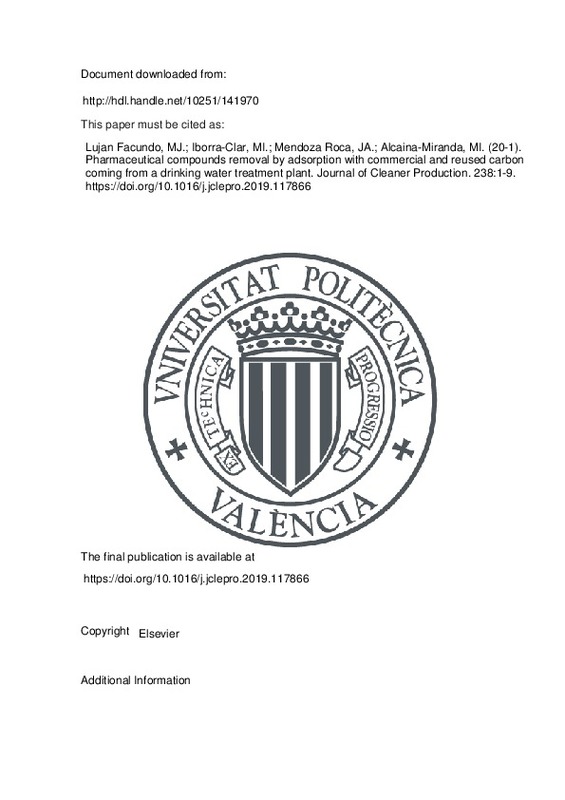JavaScript is disabled for your browser. Some features of this site may not work without it.
Buscar en RiuNet
Listar
Mi cuenta
Estadísticas
Ayuda RiuNet
Admin. UPV
Pharmaceutical compounds removal by adsorption with commercial and reused carbon coming from a drinking water treatment plant
Mostrar el registro sencillo del ítem
Ficheros en el ítem
| dc.contributor.author | Lujan Facundo, Maria Jose
|
es_ES |
| dc.contributor.author | Iborra-Clar, María Isabel
|
es_ES |
| dc.contributor.author | Mendoza Roca, José Antonio
|
es_ES |
| dc.contributor.author | Alcaina-Miranda, María Isabel
|
es_ES |
| dc.date.accessioned | 2020-04-29T07:05:23Z | |
| dc.date.available | 2020-04-29T07:05:23Z | |
| dc.date.issued | 2019-11-20 | es_ES |
| dc.identifier.issn | 0959-6526 | es_ES |
| dc.identifier.uri | http://hdl.handle.net/10251/141970 | |
| dc.description.abstract | [EN] The concern for the presence of pharmaceutical compounds in purified wastewater has grown in recent years. In this context, efficient and economically viable processes are required for their removal. In this study, adsorption was conducted to assess the removal of ibuprofen, caffeine, diazepam and acetaminophen, both as separated processes as in combination with a biological process in sequencing batch reactors. Removal efficiencies of these pharmaceutical active compounds were evaluated using two commercial activated carbons in granular and powder form and a discarded (after its use) activated carbon from a drinking water treatment plant. Concerning the biological treatment tests, simulated municipal wastewater was doped with 3¿mg/L of each pharmaceutical active compounds. Results showed that caffeine, acetaminophen and ibuprofen achieved excellent removal percentages, even without powder activated carbon addition (more than 94%); By contrast, whereas diazepam removal was low (lower than 50%); however, it was improved up to 68% with the powder activated carbon addition to the sequencing batch reactors. Regarding adsorption tests as separated process, ibuprofen was the pharmaceutical active compounds with the lowest removal percentage (around 50% for the granular activated carbon) and diazepam (around 80% for the granular activated carbon) was the compound with the maximum removal efficiency for the tested concentrations (between 0.5 and 3¿mg/L). Finally, results were very promising for the reused activated carbon since the removal efficiency of the pharmaceutical active compounds was higher than 90% (except for ibuprofen) when 0.5¿g/L of reused activated carbon was applied in powder form to solutions of 3¿mg/L of each pharmaceutical active compounds. In this way, a low cost activated carbon could be applied in wastewater treatment plants for pharmaceutical active compounds removal. | es_ES |
| dc.description.sponsorship | This work has been carried out in the frame of the project IMIDTA/2017/73 granted to the company GECIVAL, S.L. by Instituto Valenciano de Competitividad Empresarial (IVACE) within the program for research and development projects for SMEs. This project has been co-financed (50%) by the operational program FEDER of Comunitat Valenciana 2014 2020. | es_ES |
| dc.language | Inglés | es_ES |
| dc.publisher | Elsevier | es_ES |
| dc.relation.ispartof | Journal of Cleaner Production | es_ES |
| dc.rights | Reserva de todos los derechos | es_ES |
| dc.subject | Activated carbón | es_ES |
| dc.subject | Adsorption | es_ES |
| dc.subject | Pharmaceutical compounds | es_ES |
| dc.subject | Sequencing bath reactor | es_ES |
| dc.subject.classification | INGENIERIA QUIMICA | es_ES |
| dc.title | Pharmaceutical compounds removal by adsorption with commercial and reused carbon coming from a drinking water treatment plant | es_ES |
| dc.type | Artículo | es_ES |
| dc.identifier.doi | 10.1016/j.jclepro.2019.117866 | es_ES |
| dc.relation.projectID | info:eu-repo/grantAgreement/IVACE//IMIDTA%2F2017%2F73/ | es_ES |
| dc.rights.accessRights | Abierto | es_ES |
| dc.contributor.affiliation | Universitat Politècnica de València. Departamento de Ingeniería Química y Nuclear - Departament d'Enginyeria Química i Nuclear | es_ES |
| dc.description.bibliographicCitation | Lujan Facundo, MJ.; Iborra-Clar, MI.; Mendoza Roca, JA.; Alcaina-Miranda, MI. (2019). Pharmaceutical compounds removal by adsorption with commercial and reused carbon coming from a drinking water treatment plant. Journal of Cleaner Production. 238:1-9. https://doi.org/10.1016/j.jclepro.2019.117866 | es_ES |
| dc.description.accrualMethod | S | es_ES |
| dc.relation.publisherversion | https://doi.org/10.1016/j.jclepro.2019.117866 | es_ES |
| dc.description.upvformatpinicio | 1 | es_ES |
| dc.description.upvformatpfin | 9 | es_ES |
| dc.type.version | info:eu-repo/semantics/publishedVersion | es_ES |
| dc.description.volume | 238 | es_ES |
| dc.relation.pasarela | S\392962 | es_ES |
| dc.contributor.funder | European Regional Development Fund | es_ES |
| dc.contributor.funder | Institut Valencià de Competitivitat Empresarial | es_ES |







![[Cerrado]](/themes/UPV/images/candado.png)

